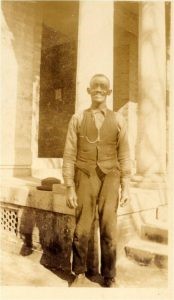This is the second part of a two-part post by Carlina Green ‘20.
You see, the Archives cannot preserve sources that are never created. And when sources are not preserved in the Archives, their subjects can be underrepresented in narratives that draw on those sources or left out of such narratives entirely.
The staff of the Archives are committed to combating these historical silences, and they work to uncover and preserve the stories of populations underrepresented in the collections they administer.[1] This includes the stories of Davidson employees. Two examples of their exemplary work profiling 19th– and 20th-century staff include Niara Webb’s blog post on “Dean of Janitors” Mr. Enoch Donaldson and Hannah Foltz’s post on Davidson’s security officer “Cop” Ed Linker. Drawing on both archival materials and public records, Webb and Foltz try to piece together portraits of these historical actors about whom little has been preserved.

However, as Cottle mentioned, the content of posts dedicated to these past staff is limited to their work experiences, as that is the main focus of preserved, available sources. Furthermore, the Archives face a paucity of sources about the lives of current Davidson employees.[2]
One solution? Creating more of these sources by collaborating with staff who want to share their stories.[3] Students, consider interviewing interested college staff for your theses, capstone projects, or summer research. Faculty, please integrate staff history projects into your courses and into your own research. And compensate staff for their interview time; take advantage of research grants available for faculty, for students, and for faculty-student collaborations.
A portion of the College’s Statement of Purpose reads, “Davidson holds a priceless heritage bequeathed by those who have dedicated their lives and their possessions for its welfare.”[4] Part of honoring staff, who dedicate so much to this campus and its students, is valuing their life stories and memories. [5] They who offer so much to the College must be preserved in its history. So, let’s fight the silences; let’s create the sources that preserve their words and their legacies.
[1] One place this commitment is visible is in their documentary Always Part of the Fabric.
[2] Two examples of sources about current staff they receive consistently are speeches delivered on Employee Appreciation Day and winner lists for annual grants and awards like the Spirit of Davidson.
[3] For those concerned about protecting staff identities, remember that interviews donated to the archives can remain closed for a period of time (such as 50 years), or they can be anonymous.
[4] Some were forced to dedicate their lives to Davidson’s welfare, such as Susan, a young girl enslaved by former College President Rev. Drury Lacy.
[5] Today, many may choose to work at Davidson, but have little choice but to work long hours at salaries a few dollars above minimum wage to support their families.

Speak Your Mind